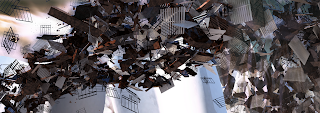Soft, Sensual, Synthetic: Green Paradigms in the Postdigital Era
Most of the contemporary and fashionable «green» concepts are the collectively acceptable mainstream leftovers or technological implementations of avant-garde thoughts, which can be traced back to the oil crisis in the seventies and the subsequent emergence of a green movement. The radical and holistic thoughts of the beginning were most notably and globally voiced in 1992 as Agenda 21 at the United Nations Conference on Environment and Development held in Rio de Janeiro. However, the roots of such movement can be traced back to the 19th century with the formation of biology as a scientific subject coining the now commonly used words habitat, milieu and ecology.
Being in the teens of the 21st century challenges us to look for new alternatives and visionary thoughts that uncover and re-integrate a relationship which has been lost in translation: man-architecture-nature.
Modernity tried to formulate a reality that was independent from nature. Architecture was raised on pilotis and sought refuge in abstract art. But in the recent past, nature has regained its place as a quintessential reference for architecture, thus seeking for a different design approach, one that is soft, sensual and more synthetic. Natural complexity and exuberance succeeded classical simplicity and reduction. Instead of opposition, man-architecture-nature is now seen as a more intertwined formation of an overall environmental/cultural/architectural manifold. More than anything, it reflects our postdigital condition in which architecture aims at a more human dimension in digital design.
It focuses on the body as an inside-out generative tool rather than architecture being generated from outside. Ultimately, this raises new questions about how the binary thinking of in/out spaces dissolves into the gradient from public space to private sphere; more fundamentally, how architecture is designed out of and within the bubbling pool of the irreducible wealth of culture, nature and human life.
For each individual research, students will be asked to associate themselves with external institutes or agencies, such as UCL Synthetic Biology, UCL Energy Institute, UCL Algae, Greenpeace UK, The European Institute for Environment and Sustainability (IES), BioBE / University of Oregon, SymbioticA / University of Western Australia.
Schedule
First project : Soft project – submission to the 9th Sao Paulo Biennale Student Competition - deadline 17.10.11
http://www.iabsp.org.br/student_contest_nonaBia.asp
Second project : Sensual (urban) project - deadline 21.11.2011
Field Trip : Brasil – Sao Paulo to Rio de Janeiro 22.11.11 – 29.11.11
Includes visit to the 9th International Architecture Biennale in Sao Paulo (02.11.11 to 04.12.11) and Olympic sites in Rio de Janeiro
Third Project : Synthetic project, to be decided individually – deadline: June 2012.























